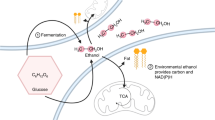Abstract
Induction of cytoplasmic pyruvate decarboxylase (PDC) in Candida utilis increases with culture age throughout aerobic logarithmic phase growth on glucose and is due to oxygen depletion. Resting cells, grown on ethanol or acetate, fail to initiate PDC synthesis for two to three hours following anaerobic suspension in glucose although these cells are capable of glucose uptake. PDC induction occurs only at permissive growth temperatures, i.e., 5 ° C to 35 ° C. A preliminary characterization of the enzyme indicates an activity optimum of 35 ° C and a lack of any regulatory properties.
Similar content being viewed by others
References
Babif, T., Moss, F. J. & Ralph, B. J., 1969. Effects of oxygen and glucose levels on lipid composition of the yeast Candida utilis grown in continuous culture. Biotech. Bioeng. 11: 593–603.
Brown, C. M. & Rose, A. H., 1969. Effects of temperature on composition and cell volume of Candida utilis. J. Bacteriol. 97: 261–272.
Bulder, C. J. E. A., 1964. Induction of petite mutation and inhibition of synthesis of respiratory enzymes in various yeasts. Antonie van Leeuwenhoek. J. Microbiol. Serol. 30: 1–9.
Colowick, S. P. & Kaplan, N. O., (eds.), 1960. Methods in Enzymology. Vol. 5. New York: Academic Press, pp. 500–501.
DeDeken, R. H., 1966. The Crabtree effect: A regulatory system in yeast. J. Gen. Microbiol. 44: 149–156.
Grant, D. W., Sinclair, N. A. & Nash, C. H., 1968. Temperature-sensitive glucose fermentation in the obligately psychrophilic yeast, Candida gelida. Can. J. Microbiol. 8: 1105–1110.
Holzer, E., Soling, H. C., Goedde, H. W. & Holzer, H., 1965. Thiamine pyrophosphate. In: Methods of Enzymatic Analysis. H. U. Bergmeyer (ed.). New York: Academic Press, p. 509.
Lowry, O. H., Rosebrough, N. J., Farr, A. L. & Randall, R. J., 1951. Protein measurement with the Folin phenol reagent. J. Biol. Chem. 193: 265–271.
Maitra, P. K. & Lobo, Z., 1971. A kinetic study of glycolytic enzyme synthesis in yeast. J. Biol. Chem. 246: 475–488.
Moss, F. J., Rickard, P. A. D., Beeck, G. A. & Bash, F. E., 1969. The response of microorganisms to steady-state in controlled concentrations of oxygen and glucose. I. Candida utilis. Biotech. Bioeng. 11: 561–580.
Author information
Authors and Affiliations
Rights and permissions
About this article
Cite this article
Franzblau, S.G., Sinclair, N.A. Induction of pyruvate decarboxylase in Candida utilis . Mycopathologia 83, 29–33 (1983). https://doi.org/10.1007/BF00437410
Issue Date:
DOI: https://doi.org/10.1007/BF00437410




